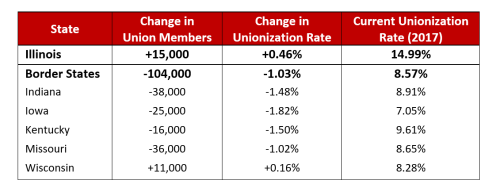2017 Illinois Unionization Rates Are Up
January 22, 2018 - CLDC LMCC LECETIllinois added 15,000 union members in 2017 while its five bordering states lost 104,000 union members.
Original Source
New Bureau of Labor Statistics data released last Friday shows that Illinois’ unionization rate increased by 0.5 percentage point in 2017. The number of union members in Illinois also increased over the year, from 812,000 to 827,000. At 15.0%, Illinois’ union membership rate now towers over each bordering state. The unionization rate in neighboring states ranges from 7.0% in Iowa to 9.6% in Kentucky.

The data also reveal that Illinois added more union members in 2017 than every bordering state. While the number of union members increased by 15,000 in Illinois, Indiana lost 38,000 members in 2017. Iowa lost 25,000 union members, Kentucky lost 16,000 union members, and Missouri lost 36,000 union members. Wisconsin was Illinois’ only neighbor to see an increase in union members with a gain of just 11,000 members.

Overall, the five states that border Illinois saw a net loss of 104,000 union members in 2017. While Illinois’ unionization rate increased by 0.5 percentage point, the neighboring states’ aggregate unionization rate fell by 1.0 percentage point. The decrease in unionization was largest in Iowa, which experienced a 1.8 percentage-point drop.

How do so-called “right-to-work” laws factor into these numbers? A “right-to-work” law is a government regulation which prohibits workers and employers from including fair-share clauses into private contracts, which ensure that workers pay dues for services provided by the labor union. Covered employees are only required to pay for the cost of bargaining and representational activities and are not forced to finance political activities. “Right-to-work,” on the other hand, makes the payment of dues optional, allowing workers in any bargaining unit to “free ride” and use union services without contributing to them. This limits union resources and reduces unionization.
All of the states that border Illinois are “right-to-work” states, except Missouri. Right-to-work laws became effective in February 2012 in Indiana, March 2013 in Michigan, March 2015 in Wisconsin, and January 2017 in Kentucky. The Missouri legislature passed a “right-to-work” bill that was set to take effect in late August 2017, but enactment was suspended after organizers collected enough signatures to delay it. In November 2018, Missouri voters will get a chance to vote for or against the “right-to-work” law.
In 2017, union membership increased more in collective-bargaining states than in “right-to-work” states. The overall number of union members increased by 140,000 members in collective-bargaining states– including the District of Columbia– and by 121,000 members in “right-to-work” states. The number of union members only fell in 7 out of 24 collective-bargaining states plus D.C. (29%) but decreased in 13 out of 27 “right-to-work” states (48%).

While these annual numbers are interesting, they should also be placed in context. In 2016, for instance, union membership increased by more than 56,000 members in collective-bargaining states but decreased by over 293,000 in “right-to-work” states. Thus, collective-bargaining states continued their gains from the previous year while “right-to-work” states were offsetting substantial losses.
Finally, the Illinois Economic Policy Institute and the University of Illinois at Urbana-Champaign released a study in 2017 which found that the introduction of “right-to-work” laws in Indiana, Michigan, and Wisconsin reduced unionization by 2.1 percentage points (and lowered worker wages by 2.6%). The fact that Illinois gained 15,000 union members while most bordering states lost members is consistent with this economic research and indicates that “right-to-work” is likely a contributing factor.

 Translate
Translate